Canine hip dysplasia (CHD) involves the abnormal growth of the hip joint, resulting in laxity or luxation. A ball-and-socket joint, the hip is designed to be a stable articulation with a vast range of motion. However, when the ball (head of the femur) or socket (acetabular cavity in the pelvis) is malformed, joint stability is lost, often leading to increased friction, cartilage loss, and the early onset of osteoarthritis and degenerative joint disease.
Hip dysplasia occurs widely in dogs and, while there are a number of risk factors, genetics play the biggest role in the development of the disease. The condition is most common in larger breed dogs, whose rapid weight gain and growth likely contribute to complications with CHD.
Table of Contents
Signs of hip dysplasia
The most common signs of hip dysplasia and associated osteoarthritis are related to the joint laxity and discomfort experienced by the pet. Owners will commonly observe:
- Rear limb lameness
- A careful or “swaying” gait
- Narrow stance
- Decreased activity levels
- Difficulty rising from sitting or lying down
- Reluctance to climb stairs or jump
- Frequent slipping on slick surfaces such as hardwood or tile flooring
Veterinarians may observe more subtle signs of hip dysplasia upon examination, such as shifting of weight to the forelimbs, rear limb muscle atrophy, or increased forelimb muscle strength. Occasionally, pets with minor hip dysplasia won’t exhibit any signs, especially in the early stages.
Diagnosing hip dysplasia
Identifying canine hip dysplasia is typically a two-step process. Veterinarians can perform certain palpation methods which may reveal hip luxation, grating, or pain. Specifically, evaluation for the Ortolani Sign in young dogs can confirm hip laxity. This manipulation is typically only done in puppies and often requires light sedation.
Radiographs (x-rays) are essential in visualizing joint luxation, osteophyte (bone spur) formation, and other signs of osteoarthritis. While traditional two or three-view films can likely confirm hip dysplasia or arthritis, a specific radiographic method known as PennHIP is ideal for an accurate diagnosis and surgical planning in young dogs with presumed dysplasia. Due to the genetic components of the disease, PennHIP or Orthopedic Foundation for Animals (OFA) radiographic examinations are recommended for pets intended to breed.
Traditional hip dysplasia treatments
Depending on the patient’s age and severity of the disease, a variety of surgical options can be pursued to address hip dysplasia. This is often the treatment of choice for immature dogs with severe diseases who would otherwise be bound to a life of chronic pain, limited mobility, and daily medications.
If medical management is elected, typical treatments involve pain medications, supplements to encourage joint lubrication and cartilage protection, and physical therapy. Other modifications can offer additional comfort to pets with hip dysplasia or osteoarthritis, such as placing toenail grips or utilizing rugs, mats, or ramps in the home.
Regardless of the elected treatment, pets with hip dysplasia should be kept at a lean weight and offered limited but routine exercise, such as gentle leash walks.
Laser therapy for hip dysplasia and osteoarthritis
Low-level laser therapy (LLLT) is an emerging treatment modality that utilizes a divergent light beam to address pain, swelling, and inflammation throughout the body. By focusing on affected tissues at a cellular level, these Class IIB medical lasers trigger beneficial physiological activities to promote healing and repair—where and when it is needed the most. This results in:
- Increased production of collagen, enzymes, and Adenosine Triphosphate (ATP, a major energy source)
- Increased protein synthesis and cellular metabolism
- Improved blood flow and lymphatic drainage
The impacts of these therapeutic effects on dogs are plentiful, including accelerated healing and reduction in chronic pain. The best part? LLLT is proven to be safe and effective with no known side effects.
While LLLT cannot reverse hip dysplasia, it may help slow the progression of secondary osteoarthritis by reducing inflammation. Additionally, LLLT can provide pain relief and quicker wound healing for pets recovering from hip surgery.
At-home laser treatment
Traditionally, dogs could only reap the benefits of laser therapy by visiting veterinary practices equipped with this then-highly specialized tool. While low-level laser therapy at home for dogs is widely available to veterinarians, it often requires specific staff training, protective eyewear, and frequent appointments for desired results to be achieved.
The B-Cure Laser Vet is a handheld device that offers all of the benefits of low-light laser therapy for use in the comfort of your own home. With its unique 4.5 cm beam, the B-Cure Laser Vet can safely and effectively provide long-lasting pain relief to the hip joints and rear limb musculature. User-friendly and cost-effective, the B-Cure Laser Vet is a great ancillary therapy that can be used in conjunction with, or as an alternative to, traditional hip dysplasia and osteoarthritis treatments, depending on the severity of the disease. The B-Cure Laser Vet is safe for use by all family members with no need for protective eyewear.
Hip dysplasia and osteoarthritis treatment protocol
The majority of dogs affected by hip dysplasia or hip osteoarthritis can adhere to the following protocol, starting with a dosage of 1.5 minutes in each position, gradually increasing the duration to 4 minutes in each position:
- Place the device behind the hip joint, vertically for 1.5 minutes
- Place the device in front of the hip joint, vertically for 1.5 minutes
- Place the device above the hip joint, horizontally for 1.5 minutes
For optimal results, repeat these steps twice daily or as directed by your veterinarian.







